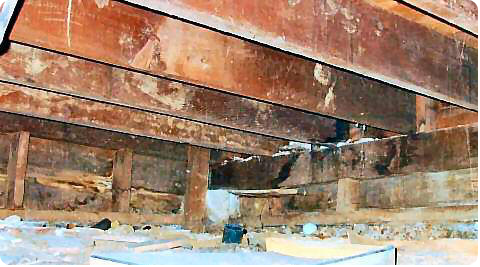
Having a crawl space with a dirt floor can result in air quality problems, mostly from humidity and moulds
Dirt or Moist Crawl Space
Having a crawl space with a dirt floor can cause other problems, mostly from humidity. There is always moisture in the porous under your home. It also contains bugs, which can crawl into your home. Another problem that you might find is odour, especially in fall or spring, when there is more moisture in the soil.
The natural air movement in your home is always upwards, due to the stack effect. Cold air pushes in from the bottom of your house through openings, cracks and supply vents, forcing warm air upward. As the heat is pushed toward the ceiling and out through your attic heating costs increase as well.

The air originating from the crawl space with a dirt floor will bring mould spores, bugs and unwanted odours into the living area.
Engineered Vapour Barrier
If you have a crawl space with a dirt floor, it is recommended it be sealed with a sheet of engineered 6 to 20-miL polyethelyne or vapour barrier to prevent ground moisture from getting into the space. It will also reduce insects and improve the overall indoor air quality. Aside from containing the dirt floor, there are a number of all natural, non-toxic solutions to treat the exposed lumber to prevent fungal growth and rot.
Drainage should be added within the lowest elevations of the crawl space. This is to ensure if there was ever any flooding, excess water will drain and prevent standing and humidity issues.
 Dirt crawl space before
Dirt crawl space before
 Completed crawl space with vapour barrier
Completed crawl space with vapour barrier
Since the crawl space is usually not heated, it should be ventilated and maintained as a cold zone. You don’t want to seal that vent up, or you’ll have problems down the road with moisture and most likely mould. The adjacent upper level above the crawl space should be properly insulated and sealed to reduce upward air movement and discourage heat loss.
The best insulation would be a closed cell, two-pound spray foam, which acts as a vapour barrier and insulation. Installing batt insulation from below is typically more difficult and does not provide as high of an R rating nor the seal of spray foam. With batt insulation, you’ll need a vapour barrier — and that has to be on the warm side of the insulation, next to the floor. A third option is would be a combination of a vapour barrier, rigid foam and batt insulation. The rigid foam should be fit tight and sealed on all edges with acoustic caulking.
Consult mr natural™ environmental group to discover a solution that is right for you.


